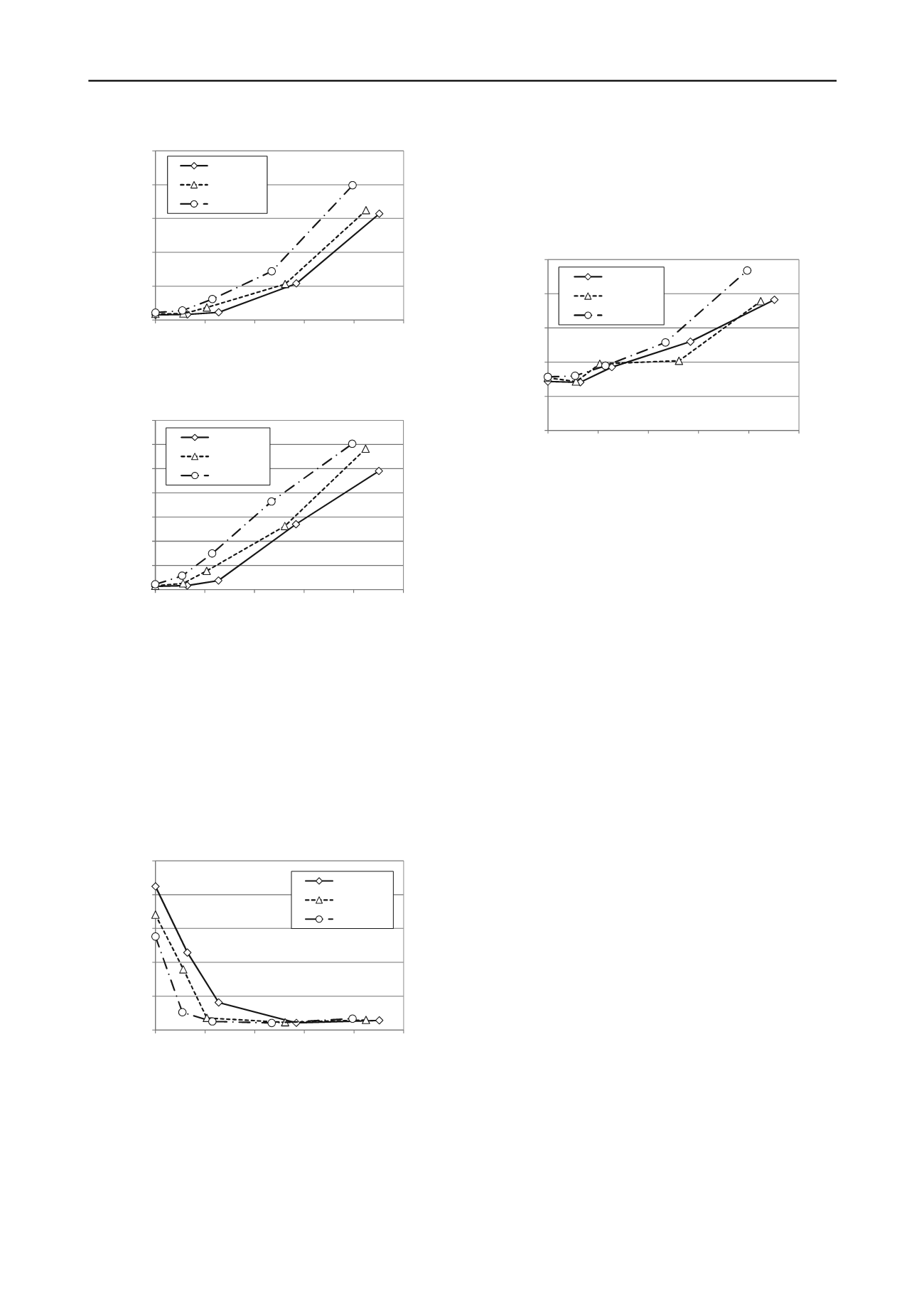
2616
Proceedings of the 18
th
International Conference on Soil Mechanics and Geotechnical Engineering, Paris 2013
0
2000
4000
6000
8000
10000
0
50
100
150
200
250
Maximum principal stress difference
(kN/m
2
)
CaCO
3
precipitation (kg/m
3
)
Dr = 30 %
Dr = 60 %
Dr = 85 %
Figure 4. Relationship between CaCO
3
precipitation and maximum
principal stress difference
0
200
400
600
800
1000
1200
1400
0
50
100
150
200
250
Secant modulus (MPa)
CaCO
3
precipitation (kg/m
3
)
Dr = 30 %
Dr = 60 %
Dr = 85 %
Figure 5. Relationship between CaCO
3
precipitation and secant modulus
(axial strain 0.4%)
3.5
Relationship between CaCO
3
precipitation and axial strain
at maximum principal stress difference
Figure 6 shows the relationship between CaCO
3
precipitation
and axial strain at the maximum principal stress difference. For
each relative density, when CaCO
3
precipitation is less than 60
kg/m
3
, the axial strain at the maximum principal stress
difference increases linearly according to the increase in
precipitation. When CaCO
3
precipitation is more than 60 kg/m
3
,
the axial strain at the maximum principal stress difference
remains in the vicinity of 0.5% and shows no difference at each
relative density.
0.0
2.0
4.0
6.0
8.0
10.0
0
50
100
150
200
250
Axial strain at maximum principle stress
difference (%)
CaCO
3
precipitation (kg/m
3
)
Dr = 30 %
Dr = 60 %
Dr = 85 %
Figure 6. Relationship between CaCO
3
precipitation and axial strain at
maximum principal stress difference
3.6
Relationship between CaCO
3
precipitation and residual
stress
Figure 7 shows the relationship between CaCO
3
precipitation
and residual stress. The residual stress indicates the minimum
principal stress difference, less than axial strain 15%, after the
maximum principal stress difference.
There is little change in the residual stress at each relative
density up to about 30 kg/m
3
of CaCO
3
precipitation in
comparison with a case of no precipitation. It is confirmed that
the residual stress increases as the CaCO
3
precipitation
increases at precipitation levels of more than 30 kg/m
3
. The
specimens for each relative density show no difference at
CaCO
3
precipitation levels less than 60 kg/m
3
, and it is unclear
whether a difference is observed at precipitation levels greater
than 60kg/m
3
.
0
200
400
600
800
1000
0
50
100
150
200
250
Residual stress (kN/m
2
)
CaCO
3
precipitation (kg/m
3
)
Dr = 30 %
Dr = 60 %
Dr = 85 %
Figure 7. Relationship between CaCO
3
precipitation and residual stress
4 CONCLUSION
We investigated the influence of the relative density of soil on
CaCO
3
precipitation by microbial metabolism and on the
soil’s
mechanical properties. The results of our experiment are as
follows:
・
The CaCO
3
precipitation tends to increase as the relative
density of the soil decreases.
・
The maximum principal stress difference increased
monotonically with the CaCO
3
precipitation at each relative
density. The secant modulus increased linearly.
・
The increase in the maximum principal stress difference was
remarkable in soils with high relative density.
・
The axial strain at the maximum principal stress difference
decreased depending on CaCO
3
precipitation in specimens of
all relative densities and became constant regardless of
CaCO
3
precipitation when it approached 0.5%.
・
The residual stress increased monotonically depending on
CaCO
3
precipitation, but the differences among the relative
densities are unclear.
・
A meaningful difference is not seen in the mechanical
properties of the soil among specimens with no precipitation
and those with CaCO
3
precipitation up to 30 kg/m
3
.
These results indicate that when applying this injection
solidification technique in the field, the density of the existing
ground will affect the strength increase. Therefore, like a
conventional compaction method used in construction, this
method would require a combination examination beforehand in
order to confirm extreme expression characteristics.
Because the axial strain at the maximum principal stress
difference becomes constant regardless of density when CaCO
3
precipitation becomes constant, we suggest that the approximate
strength of the soil can be estimated using the secant modulus.
We will investigate the influence of soil density on a
permeability change attributable to solidification by microbe
metabolism in the future.
5 REFERENCES
Victoria S. W., Leon A. P. and Marien P. H. 2007. Microbial carbonate
precipitation as a soil improvement technique.
Geomicrobiology
Journal
24, 417-423.
Y. Inagaki, M. Tsukamoto, H. Mori, S. Nakajima, T. Sasaki and S.
Kawasaki. 2011. A centrifugal model test of microbial carbonate
precipitation as liquefaction countermeasure.
Japanese
Geotechnical Journal
6, No. 2, 157-167.


